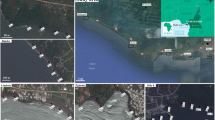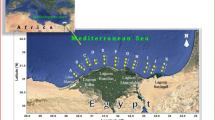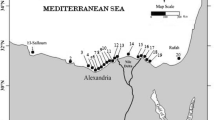Abstract
The environmental pollution indicators and multivariate statistical analysis were used to evaluate the potential ecological risk and the contamination of Fe, Mn, Zn, Ni, Pb, Cu, Cd, and Co in surface sediments of the Egyptian Red Sea coast. The results revealed that the studied area suffers from high contamination of certain metals such as the Hurghada area (Pb, Cd, Zn, Ni, and Cu), Quseir City area (Cd, Co, Pb, and Ni), and Safaga and Marsa Alam areas (Cd and Pb). Enrichment factor and principal components analysis reported that the pollution sources of Fe, Mn, and Co are related to natural weathering process while Cu, Zn, Ni, and Pb are related to anthropogenic sources as landfill, plastic rubbish, fishing boats, phosphate operations, and tourist activities. Moreover, Co and Cd metals can come from both of natural and anthropogenic sources. The average concentrations of Cd, Cu, Zn, Pb, Ni, and Co in sediments of the Egyptian Red Sea coast are higher than those in the coasts of the Red Sea (Saudi Arabia), Mediterranean Sea (Egypt and Libya), Bengal bay (India), and the Caspian Sea (Russia). However, the studied metal content is lower than the sediment quality guideline values except for Cd.




Similar content being viewed by others
References
Abdo S, Duliu O, Zinicovscaia I, Sherif M, Frontasyeva M (2017) Epithermal neutron activation analysis of major and trace elements in Red Sea scleractinian corals. J Radioanal Nucl Chem 314:1–8
Acevedo-Figueroa D, Jimenez B, Rodrigues-Sierra C (2006) Trace metals in sediments of two estuarine lagoons from Puerto Rico. Environ Pollut 141:336–342
Adamo P, Arienzo M, Imperato M, Naimo D, Nardi G, Stanzione D (2005) Distribution and partition of heavy metals in surface and sub-surface sediments of Naples city port. Chemosphere 61:800–809
Ali AA, Hamed MA, El-Azim HA (2011) Heavy metals distribution in the coral reef ecosystems of the northern Red Sea. Helgol Mar Res 65:67–80
Attia O, Ghrefat H (2013) Assessing heavy metal pollution in the recent bottom sediments of Mabahiss Bay, North Hurghada, Red Sea, Egypt. Environ Monit Assess 185(12):9925–9934
Bender M, Gagner C (1976) Dissolved copper, nickel and cadmium in the Sargasso Sea. J Mar Res 34(3):327–339
Boehme S, Panero M (2003) Pollution prevention and management strategies for cadmium in the New York/New Jersey harbor. N Y Acad Sci
Brewer P, Spencer D, Smith CL (1969) Determination of trace metals in seawater by atomic absorption spectroscopy. Am Soc Test Mater 443:70–77
Buccolieri A, Buccolieri G, Cardellicchio N, Dell'Atti A, Di Leo A, Maci A (2006) Heavy metals in marine sediments of Taranto Gulf (Ionian Sea, southern Italy). Mar Chem 99(1–4):227–235
Cameron RE (1992) A guide for site and soil description in hazardous waste site characterization. In: Superfund Risk Assessment in Soil Contamination Studies. ASTM International
Chapman PM (2007) Determining when contamination is pollution—weight of evidence determinations for sediments and effluents. Environ Int 33(4):492–501
Chen C, Kao C, Chen C, Dong C (2007) Distribution and accumulation of heavy metals in the sediments of Kaohsiung Harbor, Taiwan. Chemosphere 66(8):1431–1440
Chen T-B, Zheng Y-M, Lei M, Huang Z-C, Wu H-T, Chen H, … Fan, Ke-Ke (2005) Assessment of heavy metal pollution in surface soils of urban parks in Beijing, China. Chemosphere 60:542–551. https://doi.org/10.1016/j.chemosphere.2004.12.072
Davaulter V, Rognerud S (2001) Heavy metal pollution in sediments of the Pasvik River drainage. Chemosphere 42:9–18
De Mora S, Sheikholeslami M, Wyse E, Azemard S, Cassi R (2004) An assessment of metal contamination in coastal sediments of the Caspian Sea. Mar Pollut Bull 48(1–2):61–77
Dung T, Cappuyns V, Swennen R, Vassilieva E, Phung N (2013) Investigation of potential leachability of arsenic and heavy metals from blasted copper slag and contaminated marine sediments by single extractions in south of Van Phong Bay–Vietnam. In Proceeding of the international conference on “Bien Dong 2012 (pp. 299-308). Institute of Oceanography; Nha Trang (Vietnam)
EC, Commission Regulation (2001) No. 466/2001 of 8 March 2001. Off J Eur Commun 1.77/1
El Bassyony A (1982) Stratigraphical studies on Miocene and younger exposures between Quseir and Berenice, Red Sea coast, Egypt. PhD theism, Ain Shams University, Cairo
El Mamoney M, Rifaat A (2001) Discrimination of sources of barium in beach sediments, Marsa Alam-Shuqeir, Red Sea coast, Egypt. Mar Sci 12(1):149–160
El-Akkad S, Dardir A (1966) Geology of Red Sea coast between Ras Shagra and Mersa Alam: with short note on results of exploratory work at Gebel El-Rusas lead zinc deposits. US Government Printing Office: 67p
El-Asmar H, Abdel-Fattah Z (2000) Lithostratigraphy and facies development of the Neogene-Quaternary succession in the Marsa Alam area, Red Sea coastal plain, Egypt. Neues Jahrbuch fur Geologie und Palaontologie-Abhandlungen 217(3):397–431
El-Sorogy A, Attiah A (2015) Assessment of metal contamination in coastal sediments, seawaters and bivalves of the Mediterranean Sea coast, Egypt. Mar Pollut Bull 101:867–871
El-Sorogy A, Mohamed M, Nour HE (2012) Heavy metals contamination of the Quaternary coral reefs, Red Sea coast, Egypt. Environ Earth Sci 67(3):777–785
El-Sorogy A, El Kammar A, Ziko A, Aly M, Nour H (2013) Gastropod shells as pollution indicators, Red Sea coast, Egypt. J Afr Earth Sci 87:93–99
El-Sorogy A, Al-Kahtany K, Youssef M, Al-Kahtany F, Al-Malky M (2018) Distribution and metal contamination in the coastal sediments of Dammam Al-Jubail area, Arabian Gulf, Saudi Arabia. Mar Pollut Bull 128:8–16
EL-Wekeil S, EL-Bady M, Ramadan F, Kaiser S (2012) Geological studies of the coastal area between Mersa um Gheig and Ras Banas, Red Sea coast, Egypt. J Appl Sci Res 8(12):5860–5876
Fernex FE, Migon C, Chisholm JR (2001) Entrapment of pollutants in Mediterranean sediments and biogeochemical indicators of their impact. Hydrobiologia 450(1–3):31–46
Forstner U, Ahlf W, Calmano W (1993) Sediment quality objectives and criteria development in Germany. Water Science Technology 28:307
Gorell J, Johnson C, Rybicki B, Peterson E, Kortsha G, Brown G (1997) Occupational exposures to metals as risk factors for Parkinson’s disease. Neurology 48:650–658
Hakanson L (1980) An ecological risk index for aquatic pollution control. A sedimentological approach. Water Res 14(8):975–1001
Hume WF (1916) Report on the oilfield region of Egypt, with a geological report on the Abu Shaar El Quibli (Black Hill) District. Petrol Reserv Bull 6:103p
Irwin R, Mouwerik M, Stevens L, Seese M, Basham W (1997) Environmental contaminants encyclopedia, naphthalene entry. National Park Service: 1–80
Kabata-Pendias A, Pendias H (2001) Trace element in soils and plants, 4th edn. CRC Press, London
Kaushik A, Kansal A, Kumari S, Kaushik C (2009) Heavy metal contamination of river Yamuna, Haryana, India: assessment by metal enrichment factor of the sediments. J Hazard Mater 164:265–270
Khalil S, McClay K (2009) Structural control on syn-rift sedimentation, northwestern Red Sea margin, Egypt. Mar Pet Geol 26:1018–1034
Lin Y, Chang-Chien G, Chiang P, Chen W, Lin Y (2013) Multivariate analysis of heavy metal contaminations in seawater and sediments from a heavily industrialized harbor in Southern Taiwan. Mar Pollut Bull 76:266–275
Long E, MacDonald D, Smith S, Calder F (1995) Incidence of adverse biological effects within ranges of chemical concentrations in marine and estuarine sediments. Environ Manag 19:18–97
Mansour A, Nawar A, Mohamed A (2000) Geochemistry of coastal marine sediments and their contaminant metals, Red Sea, Egypt: a legacy for the future and a tracer to modern sediment dynamics. Sedimentol Egypt 8:231–242
Mansour A, Nawar A, Madkour H (2011) Metal pollution in marine sediments of selected harbours and industrial areas along the Red Sea coast of Egypt. Ann Naturhist Mus Wien 113:225–244
McBride MB (1994) Environmental chemistry of soils. Oxford University Press, Inc., New York
Muller G (1979) Heavy-metals in sediment of the Rhine-changes since 1971. Umschau in Wissenschaft und Technik 79(24):778–783
Mulligan C, Yong R, Gibbs B (2001) Remediation technologies for metal contaminated soils and groundwater: an evaluation. Eng Geol 60(1–4):193–207
Nawar A, Shata M (1989) Geochemistry of carbonate fraction in Mersa El-At seashore sediments, Northern Red Sea Egypt. Bull Fac Sci Zagazig Univ 11:225–236
Nour HE (2015) Distribution of hydrocarbons and heavy metal pollutants in groundwater and sediments from northwestern Libya. Ind J Geo-Mar Sci 44/7:993–999
Nour HE (2019a) Assessment of heavy metals contamination in surface sediments of Sabratha, Northwest Libya. Arab J Geosci 12:177–186
Nour HE (2019b) Distribution, ecological risk, and source analysis of heavy metals in recent beach sediments of Sharm El-Sheikh, Egypt. Environ Monit Assess 191:546
Nour HE, El-Sorogy A (2017) Distribution and enrichment of heavy metals in Sabratha coastal sediments, Mediterranean Sea, Libya. J Afr Earth Sci 134(273):222–229
Nour HE, El-Sorogy A, Abdel-Wahab M, Almadani S, Alfaifi H, Youssef M (2018) Assessment of sediment quality using different pollution indicators and statistical analyses, Hurghada area, Red Sea coast, Egypt. Mar Pollut Bull 133:808–813
Nour HE, El-Sorogy A, Abdel-Wahab M, Nouh E, Mohamaden M, Al-Kahtany K (2019) Contamination and ecological risk assessment of heavy metals pollution from the Shalateen coastal sediments, Red Sea, Egypt. Mar Pollut Bull 144:167–172
Okbah M, Nasr S, Soliman N, Khairy M (2014) Distribution and concentration status of trace metals in the Mediterranean coastal sediments, Egypt. Soil Sediment Contam Int J 23(6):656–676
Oregioni B, Astone S (1984) The determination of selected trace metals in marine sediments by flameless/flame atomic absorption spectrophotometer. - IAEA, Monaco Laboratory (Internal report). (Cited from reference methods on pollution studies N. 38, UNEP. 1986)
Özseker K, Erüz C (2011) Heavy metal (NI, CU, Pb, Zn) distribution in sediments from the coast of Trabzon in the Black Sea. Indian J Geo-Mar Sci 40(1):48–54
Persaud D, Jaagumagi R, Hayton A (1993) Guidelines for the protection and management of aquatic sediments in Ontario. Standards Development Branch. Ontario Ministry of Environment and Energy, Toronto, Canada, 27 pp
Qing X, Yutong Z, Shenggao L (2015) Assessment of heavy metal pollution and human health risk in urban soils of steel industrial city (Anshan), Liaoning, Northeast China. Ecotoxicol Environ Saf 120:377–385
Reimann C, de Caritat P (1998) Chemical elements in the environment. Factsheets for the geochemist and environmental scientist. ix+398 pp. Springer-Verlag, Berlin. ISBN 3 540 63670 6
Said R (1990) The geology of Egypt: 734 pp, Rotterdam (Balkema)
Selvaraj K, Ram Mohan V, Szefer P (2004) Evaluation of metal contamination in coastal sediments of the Bay of Bengal, India: geochemical and statistical approaches. Mar Pollut Bull 49:174–185
Shang L, Sun R, Wang Z, Ji Y, Chen L (2012) Assessment of heavy metal pollution in surface sediments of rivers in northern area of Haihe River basin, China. Huan jing ke xue = Huanjing kexue 33(2):606–611
Simeonov V, Massart D, Andreev G, Tsakovski S (2000) Assessment of metal pollution based on multivariate statistical modeling of “hot spot” sediments from the Black Sea. Chemosphere 41:1411–1417
Sinex S, Helz G (1981) Regional geochemistry of trace elements in Checapeake Bay sediments. Environ Geol 3:315–323
Song X, Shi Z, Kan Z, Liao J, Yang W, Zhang J (2014) Source identification and hazardous risk delineation of heavy metals in surface sediments from Lake Qionghai, Sichuan Province. Earth Environ 42:532–539
Taylor S (1964) Abundance of chemical elements in the continental crust: a new table. Geochim Cosmochim Acta 28:1273–1285
Thuong N, Yoneda M, Ikegami M, Takakura M (2013) Source discrimination of heavy metals in sediment and water of To Lich River in Hanoi City using multivariate statistical approaches. Environ Monit Assess 185:8065–8075
Turekian K, Wedepoh K (1961) Distribution of the elements in some major units of the earth’s crust. Am Geol Soc Bull 72:175–182
Underwood EJ (1977) Trace elements in human and animal nutrition, 4th edn. Academic, New York
USEPA (1983) Hazardous Waste Land Treatment, Office of Solid Waste and Emergency Response, US Environmental Protection Agency, Washington SW-874. p 273
USFDA United States Food and Drug Administration (1993) Guidance document for cadmium in shellfish. US Department of Health and Human Services, Public Health Service, Office of Seafood (HFS-416), 200 C Street, SW, Washington, DC, pp 44
Wang Y, Yang L, Kong L, Liu E, Wang L, Zhu J (2015) Spatial distribution, ecological risk assessment and source identification for heavy metals in surface sediments from Dongping Lake, Shandong, East China. Catena 125:200–205
Wang Q, Chen Q, Yan D, Xin S (2018) Distribution, ecological risk, and source analysis of heavy metals in sediments of Taizihe River, China. Environ Earth Sci 77:569
Wedepohl KK (1978) Handbook of geochemistry. Vol. 2, part 5. 266 figs., 576 tables, 1546 pages. Springer-Verlag, Berlin. Price DM 690.00; US 5379.50. ISBN3 540 09022 3
Wu Q, Leung JY, Geng X, Chen S, Huang X et al (2015) Heavy metal contamination of soil and water in the vicinity of an abandoned e-waste recycling site: implications for dissemination of heavy metals. Sci Total Environ 506–507:217–225
Youssef M, El-Sorogy A (2016) Environmental assessment of heavy metal contamination in bottom sediments of Al-Kharrar lagoon, Rabigh, Red Sea, Saudi Arabia. Arab J Geosci 9:474
Yu GB, Liu Y, Yu S, Wu SC, Leung AOW, Luo XS, Xu B, Li HB, Wong MH (2011) Inconsistency and comprehensiveness of risk assessments for heavy metals in urban surface sediments. Chemosphere 85(6):1080–1087
Zhang J, Liu CL (2002) Riverine composition and estuarine geochemistry of particulate metals in China-weathering feature, anthropogenic impact and chemical fluxes. Estuar Coast Shelf Sci 45:1051–1070
Zhang C, Yu Z, Zeng G, Jiang M, Yang Z, Cui F, Zhu M, Shen L, Hu L (2014) Effect of sediment geochemical properties on heavy metal bioavailibility. Environ Int 73:270–281
Ziko A, El-Sorogy A, Aly M, Nour HE (2001) Sea shells as pollution indicators, Red Sea coast, Egypt. Egypt J Paleontol 1:97–114
Acknowledgments
The authors would like to extend sincere thanks to Dr. Adham Attya for the efforts and support he provided.
Author information
Authors and Affiliations
Corresponding author
Additional information
Responsible editor: Vedula VSS Sarma
Publisher’s note
Springer Nature remains neutral with regard to jurisdictional claims in published maps and institutional affiliations.
Rights and permissions
About this article
Cite this article
Nour, H.E.S., Nouh, E.S. Comprehensive pollution monitoring of the Egyptian Red Sea coast by using the environmental indicators. Environ Sci Pollut Res 27, 28813–28828 (2020). https://doi.org/10.1007/s11356-020-09079-3
Received:
Accepted:
Published:
Issue Date:
DOI: https://doi.org/10.1007/s11356-020-09079-3




